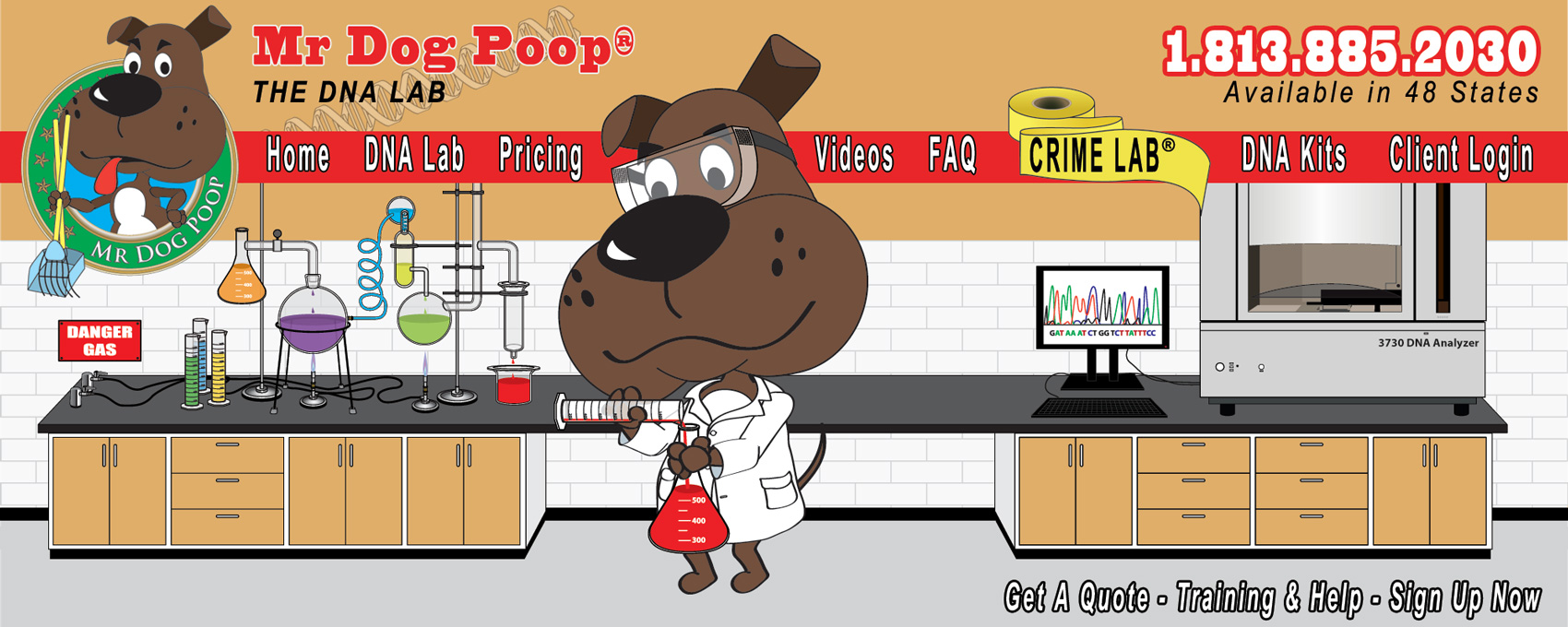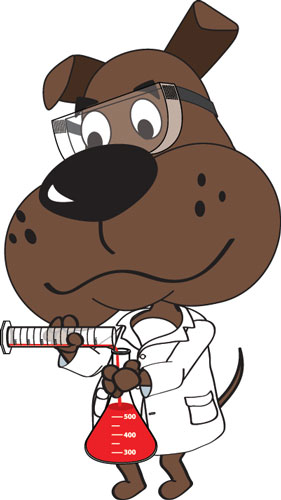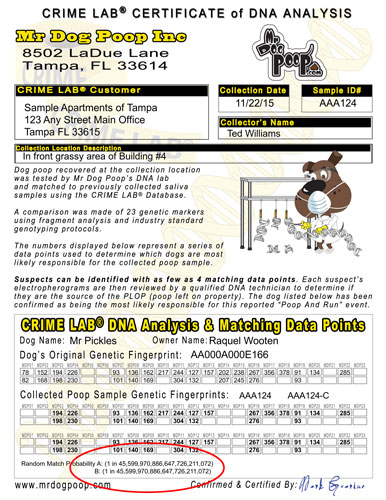The Science Behind Dog Poop DNA MatchingThe process of actually matching the DNA is complex and time intensive. Obviously, we can't hold up the two cotton swabs to a light bulb to see if they match. DNA matching is not as simple or as quick as you see on TV, in fact it is actually quite complex and is the result of years of genetic research and development by commercial companies and universities across the globe. The reliability and accuracy of DNA is well documented and has been proven in court.
Below is a sample of the data provided by the capilliary electrophoresis. The upper graph or electropherogram shows the markers collected from one of the saliva swabs and the lower graph is from a dog poop sample.
For each genetic maker there are 2 alleles represented by peaks on the graph, one is inherited from each parent. This genetic map is our digital fingerprint that we compare with other digital fingerprints from other dogs. The sample image shows only 5 markers however all comparisons are done by constructing full data sets of all 23 genetic markers logged in our database. In this case it is easy to see that the markers appear at the same points on the x axis and therefore have the same sizes confirming a positive match.
Accuracy vs Probability - Random Match ProbabilityMost people believe that a DNA match is 100% conclusive and it could have only come from the accused dog. However, that is not true. In DNA we do not talk about accuracy but rather the probability that the DNA came from a specific subject. So we use "Random Match Probability" which is the overall probability that the DNA might have come from any dog other than the accused. This number is based on all the dogs ever tested and the frequency of each allele size. A mathematical calculation is provided with each tested sample to show that it is mathematically improbable while not necessarily impossible that any other dog could match all the markers found in the poop sample. To understand how this works, let us look at a more simplified scenario with just one matching marker. For example, if we only use the sex marker and determine that the dog responsible was a male. The probability that the sample came from one particular dog would be around 1 in 2, that is if we assume that half of the population is male and half is female. Essentially, this could be any one of half the dogs on the property. As we add more markers, those numbers change and match probability is often one in billions or one in trillions and even higher. That number is important, because if the Random Match Probability is low, even though we have a match, it is impossible to say with any level of certainty that it is without doubt one particular dog. For this reason, we require a minimum number of matched markers despite often believing it is one of the registered dogs. We have to consider that any one of thousands of dogs could have entered the property and pooped. So it would be unfair to match a dog just because they are the only dog registered that matched the sample when we cannot rule out other dogs that might have visited the property. In rare cases, we have seen dogs from the same family matching several markers and if two dogs match the sample with no way to exclude either dog, it would be impossible to blame one dog over the other. Of course, if they live in the same apartment, with the same owner, we at least know who to fine. But if they have been split up and have 2 different owners on the same property, we would not be able to make the determination without additional markers. In those cases, it may not be possible to get a match with a degraded sample with only a few markers and a much better sample would be required. In uncertain cases, we typically notify the property and let them know we suspect a certain dog or dogs and advise them to keep a close watch over those dogs. Again, the DNA is a tool and it is important that we look at all the evidence available to draw conclusions. If the sample has a low Random Match Probability, does not match any other dogs on the property but was found 10 feet from the door of the suspect, there is a pretty good chance the suspect is responsible. Any additional information can also help narrow down poopetrators, photo's of the sample, location and a knowledge of which dogs are being walked in that area. For example, a Chihuahua will have significantly smaller poop than a Siberian Husky. So while properties often expect the DNA to do the work it never hurts to have additional data. If this had been a real criminal investigation, we would be getting much more data to work with such as the weight of the sample, the diameter, consistency, temperature, weather conditions, undissolved food content, hair strands, photos etc. Which is another reason why properties cannot expect the same results that would be provided in a much more thorough forensic process. Our Genotyping Is NOT Breed TestingMany people believe we can determine the breed of dogs from the DNA sample provided. However, the science of breed testing is still more predictive than actually being scientifically accurate. In fact, the science of canine DNA overall is still very young compared to our level of understanding of human DNA. While it may be possible to predict the breed of a dog through DNA analysis, this is not something we do in our lab. That would require different resources and tests. Our focus is purely scientific and only allows us to compare two samples and determine if they came from the same source. Therefore, we cannot tell anyone what type of dog they have or what mix of breeds the dog may be either from the buccal swab or poop samples. |

Mr Dog Poop Home Mr Dog Poop home page, introducing people to our company, services and the dog poop DNA testing industry.
Mr Dog Poop's DNA Lab Tour Mr Dog Poop's DNA lab, see our equipment, staff and see where we process samples the Dog Poop DNA matching process.
DNA Testing Prices Complete pricing details for Mr Dog Poop's DNA testing of cheek swabs and poop samples.
Mr Dog Poop Videos Watch promotional videos, lean about our company, process and DNA testing procedures.
Frequently Asked Questions About Dog Poop DNA Testing Answers to some of the most common questions property managers are asking about dog poop DNA testing, costs and service considerations.
Crime Lab Database The Crime Lab Database provides an inexpensive solution for apartment complexes, condo associations and others to enforce their pooper scooper rules by determining which dog left the poop based on DNA matches.
Dog Poop DNA Testing Kits Mr Dog Poop is the largest manufacturer and distributor of dog poop DNA testing products. Review the collection kits available and how they are used.
Client Login Login to manage your account, scheduling, update services, pay bills and manage your pet profiles.
Print A Formal Cost Estimate Need the costs in writing? Print a formal estimate with the costs of suggested supplies and break down of monly costs based on how many dogs you have.







